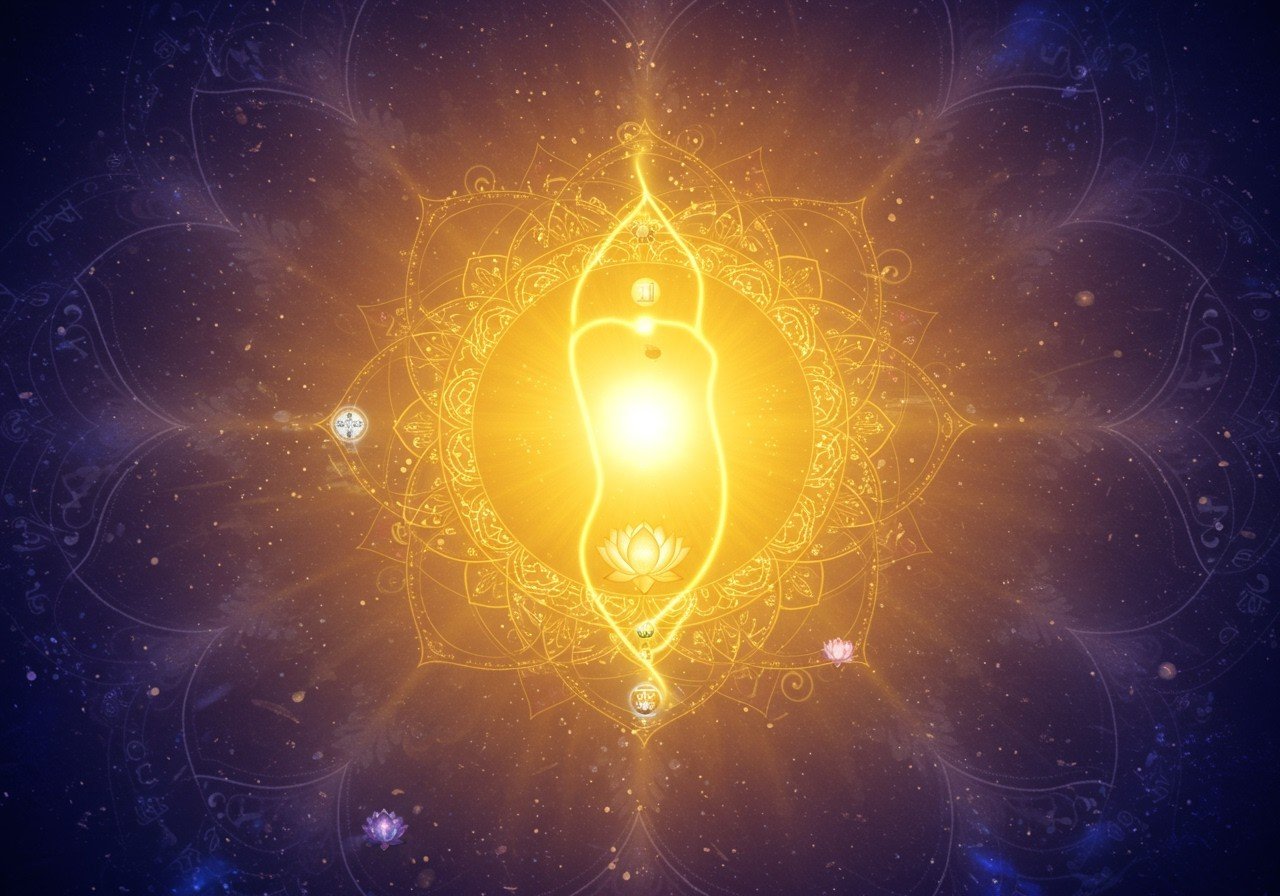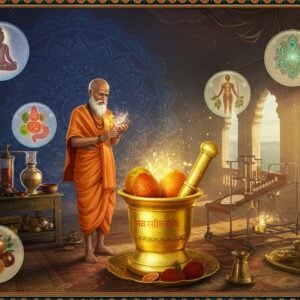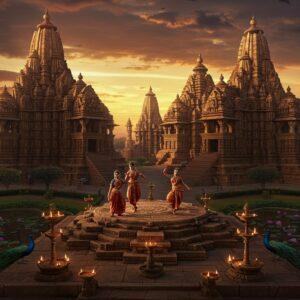
Delving into the concept of Brahman, a cornerstone of Hindu philosophy, can significantly enrich one’s spiritual understanding. Brahman represents the ultimate reality, the all-encompassing source of existence, as detailed in sacred texts like the Vedas, Upanishads, and the Bhagavad Gita. This exploration is particularly relevant for those seeking deeper meaning and connection within their spiritual lives, especially among middle to upper-middle-class Indians aged 25-60 who seek to maintain tradition while embracing modern convenience.
Brahman in the Bhagavad Gita
The Bhagavad Gita, a revered scripture within the Mahabharata, offers profound insights into the nature of Brahman. It describes Brahman as the ultimate reality, transcending both the physical and metaphysical realms. Krishna, in the Gita, reveals Brahman as the foundation of all existence, emphasizing its importance in the pursuit of liberation (moksha) and the dissolution of the ego. The Gita portrays Brahman as both immanent, pervading all things, and transcendent, existing beyond the confines of the universe. This understanding of Brahman’s dual nature sheds light on the relationship between the individual soul (Atman) and the universal soul (Brahman), highlighting the concept of non-duality (Advaita) and the interconnectedness of all beings. For a deeper dive into Hindu beliefs, explore our guide Exploring Hinduism: Core Beliefs and Practices.
Understanding Brahman in Hindu Philosophy
The Nature of Brahman
Brahman, a Sanskrit term, signifies the ultimate reality in Hindu philosophy, forming the very essence of ancient texts like the Vedas and the Upanishads. It is described as the Cosmic Principle, transcending both existence and non-existence, defying complete human comprehension and description. Brahman is often characterized as “Sat-Chit-Ananda,” embodying truth, consciousness, and bliss. As the eternal, unchanging source of creation, Brahman is the foundation upon which time, space, and natural laws emerge. For further exploration on Hindu deities, visit Hindu Gods and Goddesses: A Complete Guide.
Brahman and Atman: The Connection
The relationship between Brahman and Atman is a central theme in Hindu spirituality. The Upanishads reveal a profound connection, stating that Atman, the individual soul, is essentially Brahman, the transcendent reality. This concept of oneness is a cornerstone of non-dualistic schools of thought like Advaita Vedanta. In this perspective, Atman and Brahman share the same essence, emphasizing the spiritual unity of all beings. However, dualistic schools like Dvaita Vedanta maintain a distinction between Brahman and the individual Atman. These diverse interpretations add to the rich tapestry of Hindu philosophical thought. Learn more about the significance of Hindu temples at Hindu Temples Explained: A Guide to Their Significance.
Brahman in Different Schools of Thought
Advaita Vedanta posits nirguna Brahman, Brahman without attributes, as the sole and ultimate reality. Adi Shankara, a renowned Advaita philosopher, advocated self-inquiry as the path to realizing Brahman. Other schools of thought within Hinduism offer varying perspectives, some viewing Brahman as pervading the universe, while others perceive it as wholly transcendent, only understandable by defining what it is not. Delve into Hindu rituals with Hindu Rituals: Significance and Importance.
Brahman in the Vedas and Upanishads
The Vedas introduce the concept of Brahman as the Cosmic Principle, with references appearing in hymns of the Rigveda and Atharvaveda. The Upanishads further elaborate on Brahman, describing it as residing within the Atman, the unchanging core of each individual. A well-known Upanishadic teaching, “Tat Tvam Asi” (“That Thou Art”), encapsulates the identity of Atman and Brahman. Discover the sacred texts of Hinduism with our guide Sacred Texts of Hinduism: A Guide to Key Scriptures.
The Role of the Brahmanas
The Brahmanas are prose commentaries on the Vedas, offering explanations of Vedic rituals and their symbolic meaning. These texts contain myths, legends, philosophical discussions, and scientific knowledge from the Vedic period, including insights into astronomy and geometry. Each Veda has associated Brahmanas, providing valuable context for understanding Vedic practices and beliefs. To understand Dharma and Karma better, visit Dharma and Karma in Hinduism Explained.
Poojn.in: Supporting Your Spiritual Journey
At Poojn.in, we offer a curated selection of resources for those seeking to deepen their understanding of Brahman through scriptural study. Our collection includes authentic Vedic texts, accompanied by commentaries, and various ritual items to enhance your connection with these sacred teachings. We provide the four Vedas – Rigveda, Yajurveda, Samaveda, and Atharvaveda – in both Sanskrit and translated versions. Complementing these texts, we offer brass book stands, pure cotton asanas, traditional bell-metal lamps, and copper/brass water vessels for ritual purification. Poojn.in also provides handcrafted wooden book holders, natural cotton wicks, pure ghee, copper spoons, and traditional meditation cushions to support your spiritual practice. Explore our full range of products designed to enhance your exploration of Hindu scriptures and traditions. You can find various products related to Lord Shiva at Lord Shiva Marble Dust Murti, Standing Shiva Pure Marble Dust Murti, and Ganga Shiva Pure Marble Dust Murti. Enhance your rituals with Mangalam Camphor Butter Paper and Mangalam Camphor Tablets. Our secure packaging ensures the safe delivery of these sacred items across India.
Embracing the Journey of Understanding Brahman
Exploring Brahman in Hindu philosophy is a transformative journey into the depths of spiritual understanding. This exploration connects individuals with their cultural heritage, revealing a sense of unity and purpose through the teachings of the Vedas and Upanishads. Whether one embraces the non-dualistic view of Atman and Brahman as one or acknowledges their distinction in dualistic philosophies, the journey fosters personal growth and spiritual enlightenment. Embracing these teachings with respect and reverence allows for a balanced life, harmonizing ancient wisdom with modern living.
FAQs on Brahman
What is Brahman according to the Gita? Brahman, in the Gita, represents the ultimate reality and the supreme cosmic spirit. It is the eternal, all-encompassing source of creation, transcending human comprehension. It is the ground of being from which all things emerge and to which all things return.
How do the Vedas describe Brahman? The Vedas portray Brahman as the infinite, formless, and all-pervading reality. It is the fundamental cause of the universe, existing beyond the limitations of time and space. It is the source of all manifest and unmanifest existence.
Is Brahman mentioned in Buddhism? While not a central concept in Buddhism, some Buddhist teachings resonate with Brahman’s essence, especially regarding the interconnectedness of all beings and the concept of emptiness (sunyata) which can be seen as parallel to Brahman’s transcendence of form.
Why is Brahman important in Hinduism? Brahman holds immense importance in Hinduism as it represents the ultimate truth and reality. Understanding Brahman is seen as essential for spiritual liberation (moksha) and the realization of one’s true nature. Understanding brahman is vital for achieving self-realization and liberation from the cycle of rebirth.
How can one experience Brahman? Experiencing Brahman is often described as a process of self-realization, achievable through practices like meditation, contemplation, and the path of knowledge (jnana yoga). These practices aim to quiet the mind and reveal the underlying unity of existence. Individuals can also cultivate a deeper understanding of Brahman through studying sacred texts and engaging in selfless service.
What is the relationship between Atman and Brahman? Atman represents the individual soul, while Brahman is the universal soul or consciousness. In various Hindu philosophies, realizing the unity of Atman and Brahman is considered crucial for liberation. This realization involves understanding that the individual self is not separate from the ultimate reality, but rather a part of the whole. In the same vein, the different forms of gods and goddesses are seen as aspects of Brahman, which allows for diversity in spiritual experience.
Does Brahman have any form or attributes? Brahman is generally considered formless and without attributes (nirguna). It transcends physical and mental concepts, existing as the pure, undifferentiated consciousness underlying all phenomena. It can also be considered as saguna Brahman, having attributes, as seen in its manifestation as deities.
Can Brahman be worshipped? While Brahman itself, being formless, is not typically the object of direct worship, deities representing different aspects of Brahman are worshipped in Hinduism. This allows individuals to connect with the divine in a tangible way, while understanding that these deities are ultimately expressions of the one ultimate reality.


